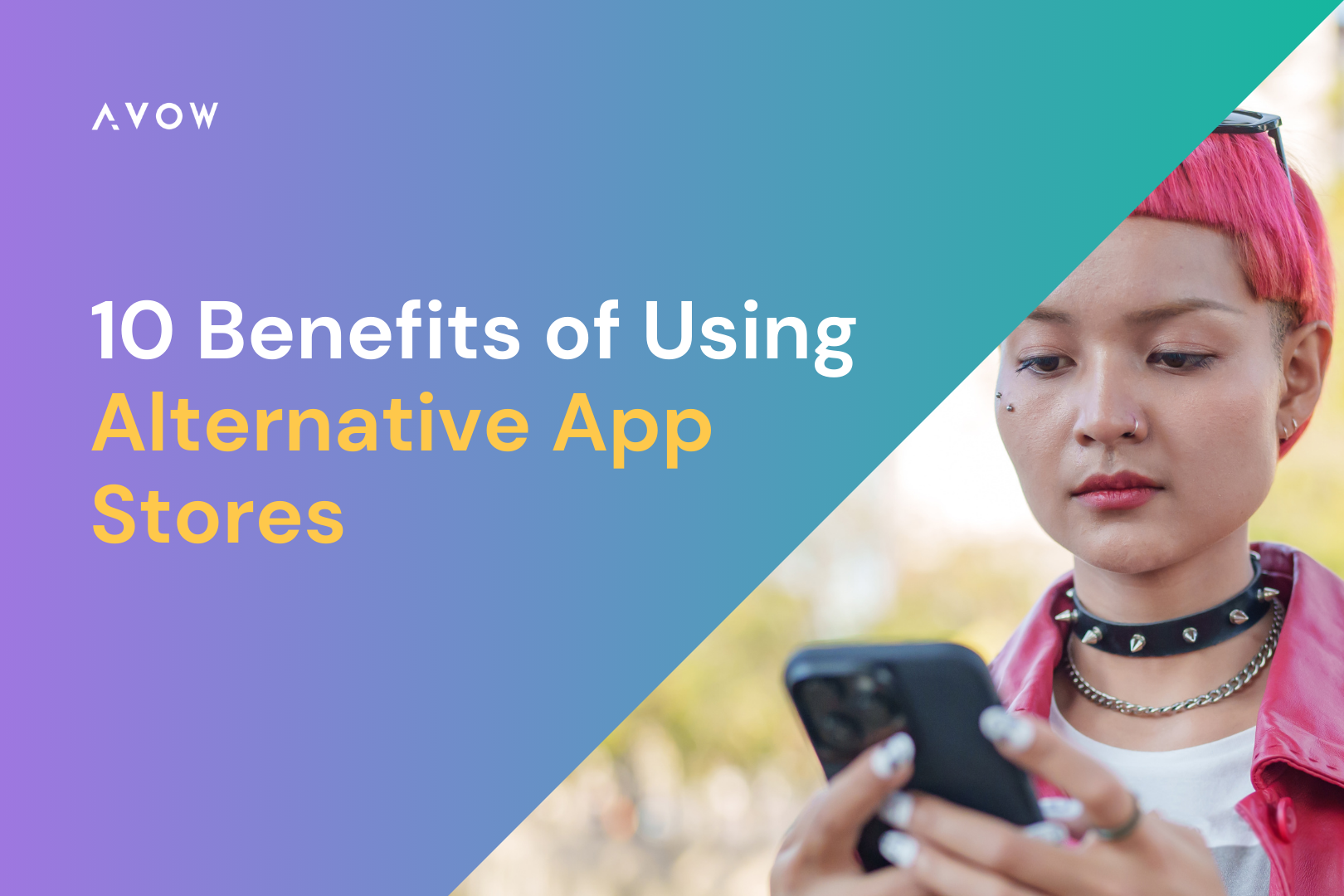Otherwise Known as Alternative App Stores, OEM Stores, or Android OEM Stores

App developers have produced a total of 8.93 million mobile apps, and there have been a staggering 255 billion app downloads already. Google Play and Apple App Store dominate today’s dynamic mobile app ecosystem. Yet, third-party or third party app stores have emerged to offer unique benefits that resonate with developers and users.
Third-party stores present opportunities that often go untouched on mainstream marketplaces, so understanding third-party app stores may be beneficial whether as an app developer trying to maximize reach or a user searching for better alternatives,
Let’s explore them together below! Here are 10 advantages of third-party platforms.

Advantages of using third party app stores
1. Expand global reach
Third-party app stores – or as we call them Alternative App Stores – often cater to specific regions or demographics, providing developers a means of penetrating markets that may otherwise remain out of their reach using traditional channels alone.
For example, in countries like China, where government restrictions block off Google Play, third-party stores serve as primary outlets for app distribution, allowing developers and marketers to tap into vast, underserved user bases more directly and expand global reach significantly. Huawei has a market share of 44.31%, thus the Huawei App Market Store is the biggest app store in China.
Moreover, alternative app stores serve niche markets, offering apps that do not conform to the rigorous criteria set by the major or premier app stores. This broader exposure can also help in boosting app downloads and user interaction, particularly in emerging markets.
2. Lower competition and greater visibility
Developers on platforms such as Google Play or the Apple App Store face one of their most significant obstacles: an overwhelming quantity of apps competing for attention. However, third party app stores typically host fewer apps, leading to decreased competition. It is an advantage which often translates into higher download rates and more excellent user retention rates. Plus, these platforms usually promote apps more prominently, giving developers and mobile marketers access to users they may never reach otherwise on more populated platforms.
3. Flexible monetization options
App monetization is an integral component of app development, and third-party app stores often provide more flexible monetization solutions compared to major app stores like Google Play and Apple App Store.
Traditional app stores such as these may charge commission rates of up to 30% on all transactions made within them. In contrast, many third-party stores typically charge lower commission rates or alternative monetization models such as direct payments, subscriptions or freemium models, giving developers more significant opportunities for experimentation when trying out various strategies to maximize revenues and maximize revenue potential.
Additionally, some alternative app stores specialize in payment methods popular in certain regions, thus increasing opportunities for further monetization opportunities in these apps and games!

Photo by Gilles Lambert on Unsplash
4. Faster and easier app approval process
App approval processes on mainstream platforms can often take an inordinately long time and it can be cumbersome, with restrictive guidelines developers must abide by. Third-party stores offer more streamlined approval processes, which allows developers to get their apps out into the market faster and with much ease.
This speed is essential if updates or bug fixes need to be released quickly to satisfy user bases. All of this only means quicker response to market needs or trends. Thus, it also offers developers more creative freedom in design/function decisions on third-party app stores than when dealing directly with mainstream platforms.
5. Expanded customizability and localization
Localization is critical to success in global markets, and third-party app stores often provide more options for customizing app listings to appeal to local audiences. Developers can customize app descriptions, screenshots, promotional materials, etc., in ways that resonate with specific regions.
For example, an app marketed in Japan may focus more heavily on features or use different imagery than one being sold in Brazil. As a result, this will help boost user engagement and conversion rates significantly. It is also crucial to remember that third-party stores supporting multiple languages make reaching non-English users easier – further improving engagement rates!
Moreover, 3rd party app stores that specialize in specific regions have various languages supported as well, making reaching non-English app users much simpler!
6. Target niche markets
Third party app stores specialize in specific areas such as games, productivity tools or educational content – providing developers with a more accessible opportunity to target niche markets effectively. A developer creating an indie game might find it hard to gain traction on
Google Play due to all of the other games offered there. By tapping into niche markets, however, they will build loyal user bases while increasing engagement rates for improved app performance and incredible revenue growth.

7. Establish trust and loyalty
Third-party app stores often foster user engagement via reviews, ratings, forums and user participation by encouraging them to write reviews or invite friends. This sense of community can foster trust among app users, who may download recommended apps more readily from trusted peers.
Positive user reviews or high ratings can significantly bolster the credibility or attractiveness of any given app. Some third-party stores even provide rewards or incentives to encourage participation (writing reviews/referring friends/etc.), creating a positive cycle where engaged users bring even more users onto their platform, thereby amplifying an app’s success further!
8. Diverse revenue streams
Third-party app stores provide developers with multiple revenue streams beyond traditional app sales and in-app purchases. These can include advertising space within the store itself, sponsorship deals and affiliate marketing programs that pay out commissions when users download specific apps within their app, drive traffic towards certain products/services, etc.
Having such sources as diversifiable income sources provides additional security – especially beneficial to indie developers/studios without enough funds available to finance large marketing initiatives.
9. Innovative marketing and promotion opportunities
Successfully marketing an app is critical to its success, and third-party app stores often provide innovative promotional opportunities not available through mainstream platforms.
These may include featuring it prominently on their homepage, running special discounts or running themed events aligning with its target audience. For example, alternative app stores that focus on education might host a back-to-school promotion to give educational apps prominence during a crucial sales period, as well as targeted efforts that drive significant traffic towards it, resulting in more app downloads and user engagement.
10. Engage users directly
One of the primary advantages of third-party app stores is being able to engage directly with their user base. Many platforms provide forums, comment sections and social media integrations where developers can directly interact with their audience.
They can gather feedback, troubleshoot issues and build loyal communities around their app through direct dialogues with their audience. Participation in these conversations allows developers to gain insight into user needs and preferences, which can lead to better app updates and improvements. Interestingly, this can also help in strengthening brand presence on a market scale.
This ongoing conversation helps boost user satisfaction as well as assist developers to establish themselves as market leaders within their industry!
Conclusion
Alternative app stores offer developers and brands many benefits that can expand their reach, increase revenue and foster meaningful user connections in meaningful ways.
From accessing global audiences and targeting niche markets to taking advantage of flexible monetization options and creative marketing solutions available via these platforms, third-party app stores create a dynamic environment for app distribution that opens new growth prospects within an already competitive app market.
By capitalizing on third-party app store potential, developers and brands can unlock growth potential that was previously hidden underground and unlock new growth prospects while staying ahead in today’s competitive app market!
Are you looking to harness alternative app stores with your app? Team up with us now to explore these platforms and reach new heights for your app!
From expanding audiences and increasing revenue streams, to improving user engagement – let our expertise assist in reaching all of these objectives and more – Contact us Now To Begin Exploring This World Of Third-Party App Stores For Your App!
Want to unlock the full blueprint of why using third party app stores is beneficial? Discover all the secrets in our Third Party App Stores: A Developer’s Comprehensive Guide!
Grow Your Reach Through Third-Party App Stores
Expand beyond Google Play and the App Store. With AVOW’s 10+ OEM partners — including Samsung, Xiaomi, OPPO, Vivo, Huawei, Transsion, OnePlus, Realme, and Honor — you can tap into 1.5 billion daily active users worldwide, boost visibility, and scale your app in untapped markets.
👉 Try our free User Reach Calculator to see your potential.

About the Author







